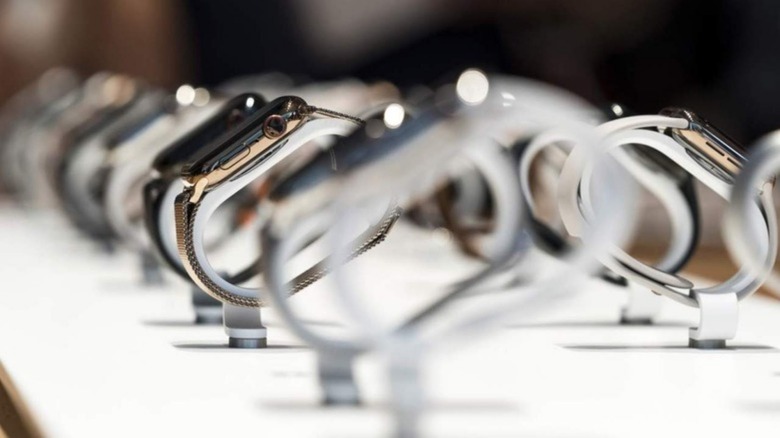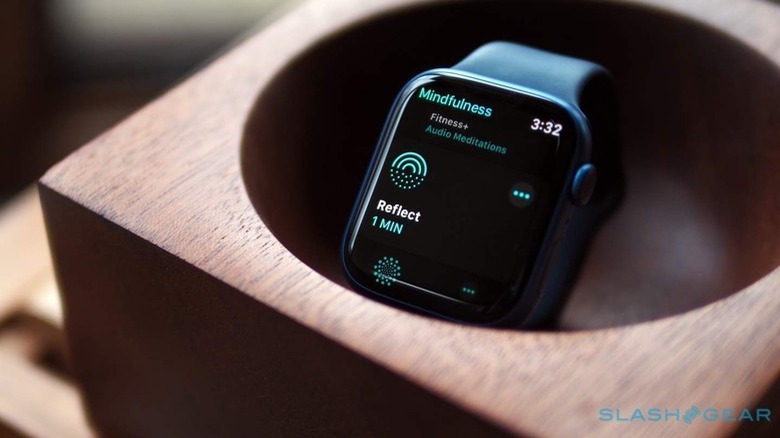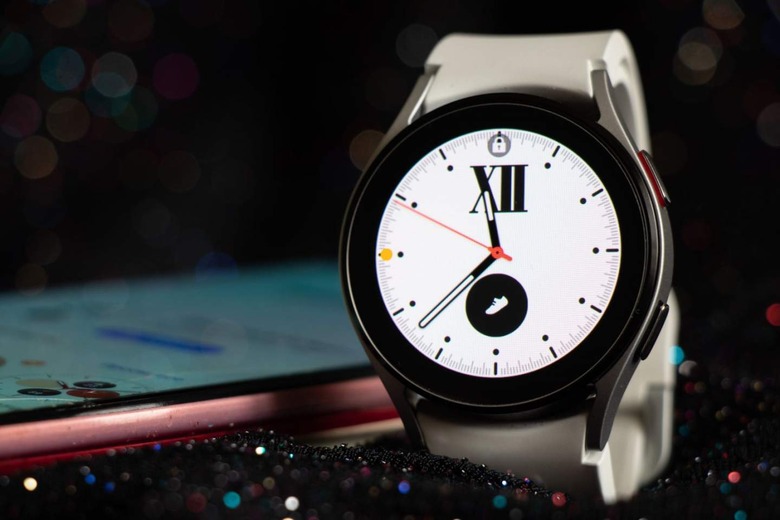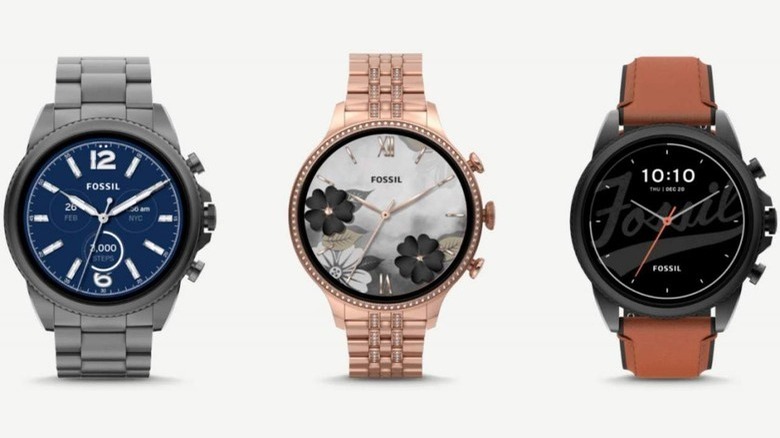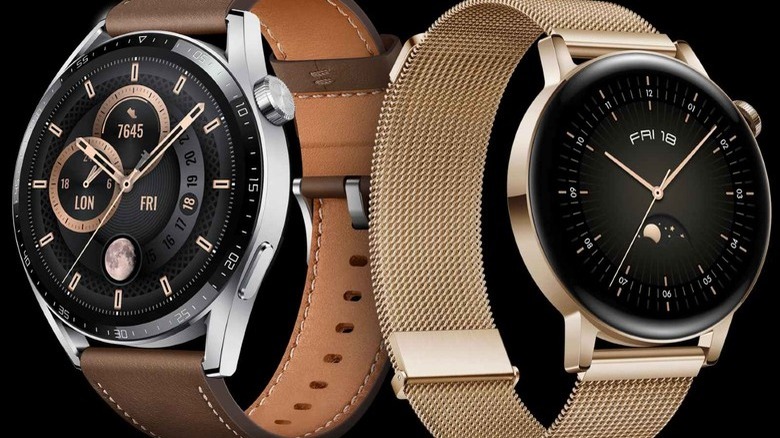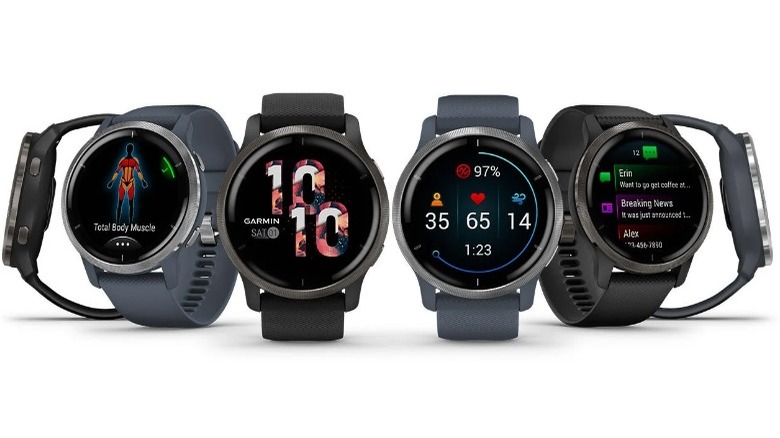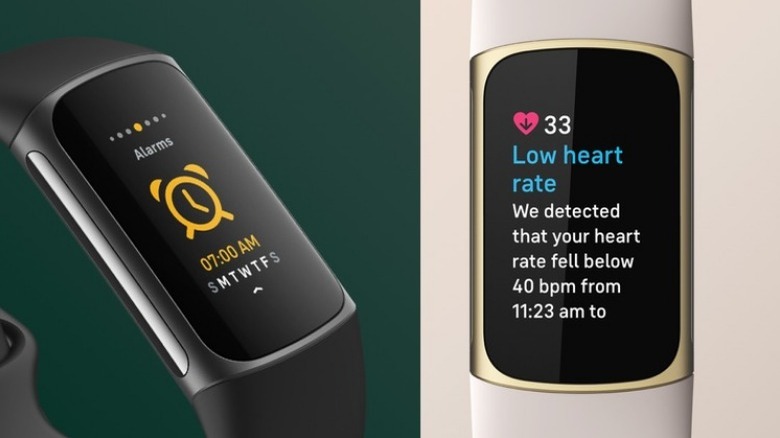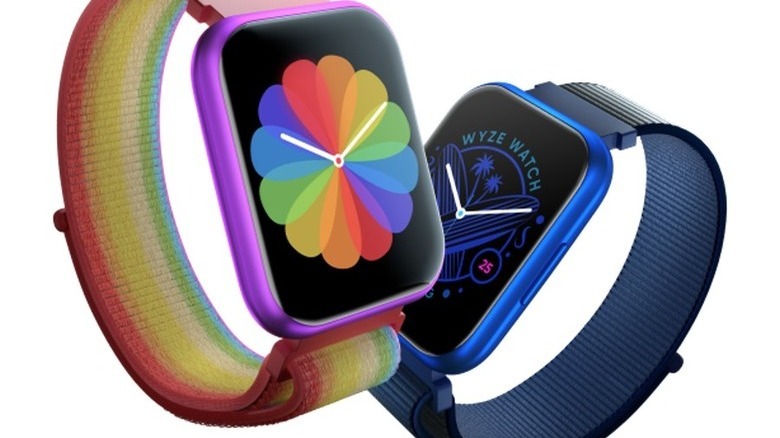The Best Smartwatches Of 2021 Ranked
More than a dozen new smartwatches were released in 2021, including updates to existing models like the Apple Watch and entirely new products like the Wyze Watch. Though many smartwatches offer similar features, some are distinguished by new innovations, higher-end versions of common functions, or other notable elements that make them stand out from the competition. The seven smartwatches on this list are all excellent options for consumers looking for their next model, covering a variety of needs ranging from low costs to advanced workout tools, mobile data access, and more.
1. Apple Watch Series 7
The Apple Watch continues to dominate the smartwatch market and for good reason. The company's latest and greatest wearable is the Apple Watch Series 7, an updated version of the smartwatch that combines high-end hardware with watchOS 8, the most recent version of Apple's wearable operating system.
The Apple Watch Series 7 sports the largest display offered on an Apple smartwatch at 1.9-inches; the Retina LTPO OLED screen has a 484 x 396 resolution, 1,000 nits peak brightness, and includes Ion-X strengthened glass for extra durability.
The display is paired with a 50-percent thicker front crystal, which, Apple says, makes the new model more durable than the Apple Watch Series 6. Despite the thicker front crystal, the touch sensor is embedded in the OLED panel to make it a single integrated component. The overall display thickness and borders are thinner as a result.
While the Apple Watch Series 7 hardware is great, it's Apple's watchOS software that makes its smartwatch shine. WatchOS 8 brings a huge number of features to the tiny device, enabling it to perform fairly sophisticated actions (like phone calls) on its own while also integrating with the wider Apple ecosystem. One can, for example, answer a call on their Apple Watch when away from their phone, then transfer the call with a tap to continue it on their iPhone.
Apple covers all the major feature categories with its smartwatch, including messaging, sleep tracking, activity tracking, workout instructions, health monitoring, smart home control, audio playback, mobile payments, Siri access, navigation instructions, ultra-wideband digital key support, and the ability to link with other family members' watches for direct interactions. One of the most notable features is the Apple Watch's ECG feature for heart health monitoring.
The Apple Watch's only potential downside (its $399 starting price aside) is that it is an Apple device and therefore designed to integrate with the company's own products and services. Consumers who don't own any other Apple products should instead consider a smartwatch model designed to work well with Android smartphones, including the six great options below.
2. Samsung Galaxy Watch 4
Though Apple dominates the overall smartwatch market, Samsung continues to rank at the top when it comes to wearables targeting non-Apple users. Samsung's strength was made clear earlier this year when it teamed with Google to unify Wear OS and its Tizen platform, leading to a huge spike in Wear OS market share. The Galaxy Watch 4 is Samsung's latest flagship smartwatch, combining a high-quality build with advanced Wear OS features.
The Galaxy Watch 4 features a 1.2-inch or 1.4-inch display, depending on whether you're considering the 40mm or 44mm version of the watch. Both displays are circular Super AMOLED panels with Gorilla Glass DX+ and support for always-on functionality with full colors. The body, meanwhile, is made from Samsung's extra-durable "Armor Aluminum," boasting an IPX8 rating with water resistance down to 5ft for up to half an hour.
As with Apple, Samsung has managed to pack a huge number of features in its latest Galaxy smartwatch, including sleep tracking with snoring detection, real-time ECG measurements with the company's BioActive Sensor, activity and workout tracking, group activity challenges, simplified health insights, support for dynamic watch faces, mobile payment support, navigation, audio playback, and access to the vast Wear OS app library.
The Galaxy Watch 4 isn't the first Wear OS option on the market, but sticking with Samsung's Galaxy line comes with some benefits over the competition, including the company's wide network of service partners for getting device repairs, as well as Samsung's financing option for customers who want to pay monthly.
Samsung's new flagship is also affordable for a high-end wearable at $249 USD (Bluetooth/WiFi version) and $299 (4G LTE variant). All major wireless carriers in the US are supported, including Verizon, T-Mobile, AT&T, and US Cellular.
iPhone owners should stick with the Apple Watch, but Android users will find the Galaxy Watch 4 a better alternative, though there's one huge catch: the ECG feature only works with the Samsung Health Monitor app, which is only available on unmodified Samsung smartphones. If you don't own a Galaxy handset, the Fossil model below may be a more appealing option.
3. Fossil Gen 6
Fossil released the latest version of its smartwatch, the Gen 6, earlier this year, giving consumers another high-end Wear OS option combining an attractive design with notable features. In addition to the various Wear OS functionality, the Fossil Gen 6 has fast-charging support that gets it to 80-percent battery in around half an hour. As well, Fossil offers a large selection of customizable bands and dials, enabling customers to get a watch with styles ranging from minimalist and modern to sporty and classic.
The Fossil Gen 6 is a 44mm smartwatch featuring a 1.28-inch circular AMOLED display with a 416 x 416 resolution. The device is powered by the Snapdragon Wear 4100+ alongside 1GB of RAM and 8GB of storage. In addition to the usual sensors found in smartwatches (gyroscope, etc.), this model also has a built-in microphone and loudspeaker for taking calls and using voice assistants.
Other notable features include a 3ATM water resistance rating (WATCHO has more details on what this means), around 24 or so hours of runtime on a full charge with Extended Mode, a GPS sensor for navigation and location tracking, support for mobile payments, continuous heart rate tracking with a PPG (light-based) heart rate sensor, and two configurable push buttons.
The hardware aside, the Fossil Gen 6 offers many of the same features as Samsung's Galaxy Watch 4 because it runs Google's Wear OS. Users can, for example, receive and make calls from the smartwatch, view their activity stats, track how many calories are burned, set sleep goals, monitor sleep patterns, access Google Assistant, use mobile pay, and stream music from supported platforms like Spotify and YouTube Music.
Beyond that, users can swim while wearing the watch, control compatible smart home devices, enable social-based watch faces, rapidly download content from phone to watch over Bluetooth 5, and download apps from the Wear OS library.
The Fossil Gen 6 is one of the pricier smartwatches on the market at $299, though it is currently discounted to $229. The price varies based on which dial and bands you choose, however; the Smoke Stainless Steel version, for example, has a regular price of $319 USD. The silicone watch band is $29, while the leather bands are $39 and the metal/mesh options are $49.
Do you like Fossil's classy style options but want a smartwatch that's a bit larger? That's where Huawei's latest flagship wearable comes in.
4. Huawei Watch GT 3
Huawei, despite its struggles, released its Watch GT 3 wearable this year. The smartwatch features an attractive design that makes it a great option for consumers who often attend formal events or anyone seeking a wearable that doesn't stick out. Despite masquerading as an ordinary timepiece, the Huawei Watch GT 3 packs a number of high-end smart features.
One of the watch's more interesting features is the AI running coach, which, as its name suggests, leverages artificial intelligence to help runners improve their performance. Huawei claims its AI running coach analyzes the user's running data over time to generate a "scientific and professional running plan" across all skill levels. The system is also able to automatically make changes to the running plan over time as the user engages in the activity, therefore providing more data to analyze.
Huawei goes on to explain that other factors, including the runner's heart rate, pace, and running distance, are used to tailor training recommendations for each individual. The model's offline navigation support also makes it possible for runners to get directions back home, view suggested routes, view estimated arrival time, and similar.
The watch also targets other athletes, including those who participate in skiing, swimming, cycling, and hiking. Users can stream music to Bluetooth headphones from their watch, eliminating the need to carry their phone with them while active, plus the watch is compatible with some third-party fitness apps and sports equipment. When applicable, the user can link their Watch GT 3 with, for example, their rowing machine or treadmill to sync their performance data with other fitness apps.
The Watch GT 3 is notable because it offers so many fitness and activity features despite being a full smartwatch, not a tracker. Users get access to the variety of other features expected from a wearable, including sleep monitoring, the ability to answer and decline calls (over a Bluetooth connection with a smartphone), wireless charging support, heart rate and blood oxygen saturation monitoring, the ability to change watch faces, a "rotating crown" dial for controlling apps, support for reminders, and access to key daily info like the weather.
Consumers should keep in mind one big limitation, however, which is that Huawei's latest smartwatch runs the company's Harmony OS, not Wear OS. While Harmony OS is a decent alternative to Google's software, it comes with very limited third-party app support. The Watch GT 3 technically supports linking data with third-party fitness apps, but that feature is entirely dependent on those apps actually supporting the proprietary platform — of which, most do not.
This means users will mostly be stuck using Huawei's own Health app, and though that's not necessarily a bad thing, the lack of options makes this model far less appealing than a Wear OS alternative despite its beautiful aesthetics and high-end fitness features. The Huawei Watch GT 3 is available in the US for around $300, depending on the retailer.
5. Garmin Venu 2
Garmin released the Venu 2 this year, presenting its wearable as a GPS smartwatch designed around "advanced health and monitoring features." Though the Venu 2 is a proper smartwatch, it heavily focuses on activity tracking and health monitoring. Users can, for example, watch animated workouts directly on the watch when they want to exercise, use more than two dozen bundled sports apps, and view a variety of details related to their health and activity habits.
Garmin's latest watch includes a pulse oxygen sensor, heart rate monitoring, respiration tracking, and a "health snapshot" feature that provides details based on a quick 2-minute activity session.
The company's companion mobile app offers expanded logging features so that users can keep track of other aspects of their life, including pregnancy and menstrual cycle tracking, hydration tracking, and stress tracking. The features are rounded out by a mindfulness breathing function directly on the watch, sleep monitoring features that generate charts, Garmin's Body Battery energy monitoring tool, and a feature that uses one's personal info and activity data to generate a "fitness age."
As mentioned, the Venu 2 is a full smartwatch, not just a fitness tracker. In light of that, it's not surprising users also get access to select phone alerts, assuming the watch is paired with a compatible smartphone. The device also features Garmin Pay for mobile payments, apps available to download through the Connect IQ Store, access to major music streaming services for phone-free audio access, and an assistance feature.
The Venu 2 is an excellent option for consumers who are very active and want a smartwatch primarily for health and fitness reasons. However, as with Huawei's new model, there's one potential downside: Garmin uses its proprietary Connect platform with the wearable, not Google's Wear OS. This means users may not get access to all of the third-party wearable apps they want.
Garmin does a great job offering a robust platform and it is entirely possible users will get access to all of the apps and features they want with the Venu 2. At $399, however, the model is one of the most expensive smartwatches on the market. Many consumers will likely find the fitness features offered by cheaper models suitable for their needs; Garmin's model is targeted more at athletes who need advanced features. If that describes you — and you won't miss Wear OS — the Venu 2 is a solid option.
6. Fitbit Charge 5
The Fitbit Charge 5 launched this year as a sort of hybrid device — though it's technically not a smartwatch, at least not like the others on this list, it offers enough features that it exceeds what you'd typically get from a fitness tracker.
In addition to typical tracking features like step monitoring, the Charge 5 also includes health features, the most notable of which is an ECG app that helps users detect whether they may be experiencing an irregular heartbeat. The health features also include oxygen saturation monitoring, breathing rate, skin temperature tracking, menstrual cycle tracking, sleep monitoring with info about sleep stages and a nightly sleep score, a stress management score, plus a feature called Reflections that lets users log their moods everyday.
The health features are joined by a number of fitness-centric functions, including tracking and details on things like how many minutes are spent in the "active zone," a daily readiness score, a workout intensity mode, SmartTrack, all-day activity tracking, and a VO2 max measurement tool that shows one's cardio fitness level over time. The wearable includes a variety of hardware and software features that help users stay on top of their fitness, as well.
The device includes a heart rate sensor for 24/7 heart rate tracking, plus there's integrated GPS for recording routes and viewing real-time distance/pace info without carrying a smartphone. The device is water-resistant to depths of around 164ft, meaning it'll be safe to use it while in the rain, as well. Fitbit's latest wearable provides access to 20 different exercise modes like cycling and running, but it also packs a few of the key features available on general smartwatches.
When paired with a smartphone, users can get a variety of notifications on the Charge 5, including text and call alerts, calendar event notifications, and Facebook/WhatsApp alerts. The Fitbit Charge 5 also supports mobile payments, meaning a user can pop into the nearest convenience store during their run and use their wrist to pay for a drink.
The company's Smart Wake feature triggers an alarm that goes off at the ideal time within a 30-minute window around one's set alarm, plus there's a sleep mode and a Do Not Disturb mode. The watch offers up to seven days of runtime on a charge and allows users to swap out the wristbands.
Though users won't get some of the more advanced smartwatch features like texting, the Fitbit Charge 5 is a well-rounded wearable that, despite its health and fitness nature, offers enough features to technically qualify as a smartwatch. The model is particularly attractive for users who aren't looking to spend too much, as it costs only $129.
7. Wyze Watch
Wyze, a company that first found success by selling an ultra-cheap home security camera, has since expanded beyond consumer security products to launch a variety of connected and smart gadgets. One of the latest devices in this lineup, the Wyze Watch, arrived earlier this year as a budget alternative to major smartwatch models.
Wyze Watch is large with a 1.75-inch display and, despite its $30 price tag, the model sports an all-aluminum frame. The most recent version of this wearable, the Wyze Watch 47c, packs a blood oximeter for monitoring blood oxygen saturation levels. The device is also able to monitor the user's heart rate, steps taken throughout the day, and monitor sleep quality at night.
The company added four new color options to its smartwatch, plus customers can choose from a variety of watchband designs, including a rainbow strap, ostentatious colors like neon yellow, and classier options like brown leather.
The watch manages to pack some notable capabilities at a budget price; users can, for example, change the watch face to a number of different options, and the wearable offers up to nine days of runtime before it needs to be recharged. The Wyze Watch has an IP68 waterproof rating for use in water to depths of around 6.5ft for up to half an hour.
Though this wearable doesn't offer some of the bigger features available with the other smartwatches on this list, Wyze Watch earns its place among the year's most notable models because it manages to cover so many key features at a price point just about anyone can afford. The wearable is ideal for consumers who aren't sure whether they'll actually get much use out of a smartwatch and therefore don't want to spend too much until they know for sure.
The Wyze Watch is also a great option for kids and teens who may not require the more advanced features of a pricey alternative, and for anyone who wants a cheap model to wear while at work or in risky environments, allowing them to keep their more expensive wearable safely at home.
